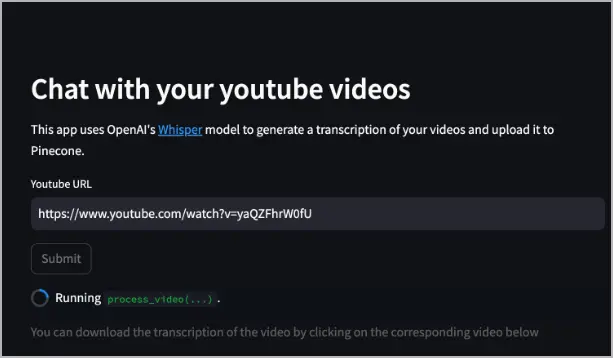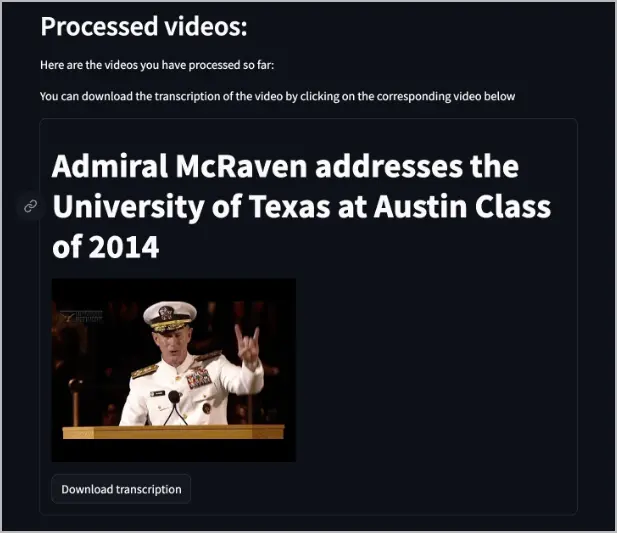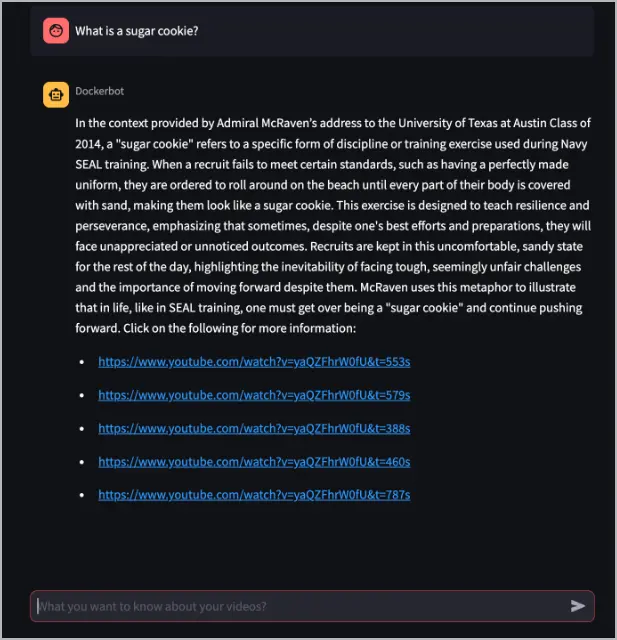GenAI video transcription and chat
Overview
This guide presents a project on video transcription and analysis using a set of technologies related to the GenAI Stack.
The project showcases the following technologies:
- Docker and Docker Compose
- OpenAI
- Whisper
- Embeddings
- Chat completions
- Pinecone
- Retrieval-Augmented Generation
Acknowledgment
This guide is a community contribution. Docker would like to thank David Cardozo for his contribution to this guide.
Prerequisites
You have an OpenAI API Key.
NoteOpenAI is a third-party hosted service and charges may apply.
You have a Pinecone API Key.
You have installed the latest version of Docker Desktop. Docker adds new features regularly and some parts of this guide may work only with the latest version of Docker Desktop.
You have a Git client. The examples in this section use a command-line based Git client, but you can use any client.
About the application
The application is a chatbot that can answer questions from a video. In addition, it provides timestamps from the video that can help you find the sources used to answer your question.
Get and run the application
Clone the sample application's repository. In a terminal, run the following command.
$ git clone https://github.com/Davidnet/docker-genai.gitThe project contains the following directories and files:
├── docker-genai/ │ ├── docker-bot/ │ ├── yt-whisper/ │ ├── .env.example │ ├── .gitignore │ ├── LICENSE │ ├── README.md │ └── docker-compose.yamlSpecify your API keys. In the
docker-genaidirectory, create a text file called.envand specify your API keys inside. The following is the contents of the.env.examplefile that you can refer to as an example.#---------------------------------------------------------------------------- # OpenAI #---------------------------------------------------------------------------- OPENAI_TOKEN=your-api-key # Replace your-api-key with your personal API key #---------------------------------------------------------------------------- # Pinecone #---------------------------------------------------------------------------- PINECONE_TOKEN=your-api-key # Replace your-api-key with your personal API keyBuild and run the application. In a terminal, change directory to your
docker-genaidirectory and run the following command.$ docker compose up --buildDocker Compose builds and runs the application based on the services defined in the
docker-compose.yamlfile. When the application is running, you'll see the logs of 2 services in the terminal.In the logs, you'll see the services are exposed on ports
8503and8504. The two services are complimentary to each other.The
yt-whisperservice is running on port8503. This service feeds the Pinecone database with videos that you want to archive in your knowledge database. The following section explores this service.
Using the yt-whisper service
The yt-whisper service is a YouTube video processing service that uses the OpenAI Whisper model to generate transcriptions of videos and stores them in a Pinecone database. The following steps show how to use the service.
Open a browser and access the yt-whisper service at http://localhost:8503.
Once the application appears, in the Youtube URL field specify a Youtube video URL and select Submit. The following example uses https://www.youtube.com/watch?v=yaQZFhrW0fU.


The yt-whisper service downloads the audio of the video, uses Whisper to transcribe it into a WebVTT (
*.vtt) format (which you can download), then uses the text-embedding-3-small model to create embeddings, and finally uploads those embeddings in to the Pinecone database.After processing the video, a video list appears in the web app that informs you which videos have been indexed in Pinecone. It also provides a button to download the transcript.


You can now access the dockerbot service on port
8504and ask questions about the videos.
Using the dockerbot service
The dockerbot service is a question-answering service that leverages both the Pinecone database and an AI model to provide responses. The following steps show how to use the service.
NoteYou must process at least one video via the yt-whisper service before using the dockerbot service.
Open a browser and access the service at http://localhost:8504.
In the What do you want to know about your videos? text box, ask the Dockerbot a question about a video that was processed by the yt-whisper service. The following example asks the question, "What is a sugar cookie?". The answer to that question exists in the video processed in the previous example, https://www.youtube.com/watch?v=yaQZFhrW0fU.


In this example, the Dockerbot answers the question and provides links to the video with timestamps, which may contain more information about the answer.
The dockerbot service takes the question, turns it into an embedding using the text-embedding-3-small model, queries the Pinecone database to find similar embeddings, and then passes that context into the gpt-4-turbo-preview to generate an answer.
Select the first link to see what information it provides. Based on the previous example, select https://www.youtube.com/watch?v=yaQZFhrW0fU&t=553s.
In the example link, you can see that the section of video perfectly answers the question, "What is a sugar cookie?".
Explore the application architecture
The following image shows the application's high-level service architecture, which includes:
- yt-whisper: A local service, ran by Docker Compose, that interacts with the remote OpenAI and Pinecone services.
- dockerbot: A local service, ran by Docker Compose, that interacts with the remote OpenAI and Pinecone services.
- OpenAI: A remote third-party service.
- Pinecone: A remote third-party service.


Explore the technologies used and their role
Docker and Docker Compose
The application uses Docker to run the application in containers, providing a consistent and isolated environment for running it. This means the application will operate as intended within its Docker containers, regardless of the underlying system differences. To learn more about Docker, see the Getting started overview.
Docker Compose is a tool for defining and running multi-container applications.
Compose makes it easy to run this application with a single command, docker compose up. For more details, see the
Compose overview.
OpenAI API
The OpenAI API provides an LLM service that's known for its cutting-edge AI and machine learning technologies. In this application, OpenAI's technology is used to generate transcriptions from audio (using the Whisper model) and to create embeddings for text data, as well as to generate responses to user queries (using GPT and chat completions). For more details, see openai.com.
Whisper
Whisper is an automatic speech recognition system developed by OpenAI, designed to transcribe spoken language into text. In this application, Whisper is used to transcribe the audio from YouTube videos into text, enabling further processing and analysis of the video content. For more details, see Introducing Whisper.
Embeddings
Embeddings are numerical representations of text or other data types, which capture their meaning in a way that can be processed by machine learning algorithms. In this application, embeddings are used to convert video transcriptions into a vector format that can be queried and analyzed for relevance to user input, facilitating efficient search and response generation in the application. For more details, see OpenAI's Embeddings documentation.


Chat completions
Chat completion, as utilized in this application through OpenAI's API, refers to the generation of conversational responses based on a given context or prompt. In the application, it is used to provide intelligent, context-aware answers to user queries by processing and integrating information from video transcriptions and other inputs, enhancing the chatbot's interactive capabilities. For more details, see OpenAI's Chat Completions API documentation.
Pinecone
Pinecone is a vector database service optimized for similarity search, used for building and deploying large-scale vector search applications. In this application, Pinecone is employed to store and retrieve the embeddings of video transcriptions, enabling efficient and relevant search functionality within the application based on user queries. For more details, see pincone.io.
Retrieval-Augmented Generation
Retrieval-Augmented Generation (RAG) is a technique that combines information retrieval with a language model to generate responses based on retrieved documents or data. In RAG, the system retrieves relevant information (in this case, via embeddings from video transcriptions) and then uses a language model to generate responses based on this retrieved data. For more details, see OpenAI's cookbook for Retrieval Augmented Generative Question Answering with Pinecone.
Next steps
Explore how to create a PDF bot application using generative AI, or view more GenAI samples in the GenAI Stack repository.